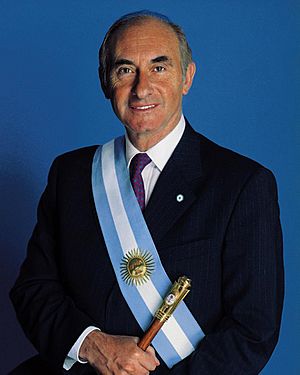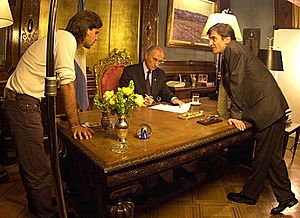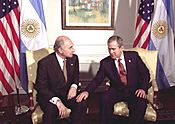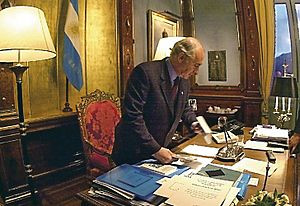Fernando de la Rúa facts for kids
Quick facts for kids
Fernando de la Rúa
|
|
|---|---|

Official portrait, 1999
|
|
| President of Argentina | |
| In office 10 December 1999 – 21 December 2001 |
|
| Vice President | Carlos Álvarez (1999–2000) None (2000–2001) |
| Preceded by | Carlos Menem |
| Succeeded by | Ramón Puerta (acting) |
| Chief of Government of Buenos Aires | |
| In office 7 August 1996 – 10 December 1999 |
|
| Deputy | Enrique Olivera |
| Preceded by | Jorge Domínguez (appointed intendant) |
| Succeeded by | Enrique Olivera |
| National Senator | |
| In office 10 December 1993 – 7 August 1996 |
|
| Constituency | City of Buenos Aires |
| In office 10 December 1983 – 10 December 1987 |
|
| Constituency | City of Buenos Aires |
| In office 25 May 1973 – 24 March 1976 |
|
| Constituency | City of Buenos Aires |
| National Deputy | |
| In office 10 December 1991 – 10 December 1993 |
|
| Constituency | City of Buenos Aires |
| Personal details | |
| Born | 15 September 1937 Córdoba, Argentina |
| Died | 9 July 2019 (aged 81) Loma Verde, Argentina |
| Political party | Radical Civic Union / Alliance |
| Spouse |
Inés Pertiné Urien
(m. 1970) |
| Children | 3, including Antonio |
| Alma mater | National University of Córdoba |
| Signature | |
Fernando de la Rúa (born September 15, 1937, died July 9, 2019) was an Argentine politician. He was a member of the Radical Civic Union (UCR) political party. He served as the President of Argentina from December 10, 1999, to December 21, 2001. De la Rúa was born in Córdoba. He became involved in politics after studying law.
Contents
Fernando de la Rúa: A Look at His Life
Early Life and First Steps in Politics
Fernando de la Rúa was born in Córdoba. His parents were Eleonora Bruno and Antonio De la Rúa. He went to the local Military Lyceum. Then, he studied at the National University of Córdoba. He earned a law degree when he was 21 years old.
In 1970, he married Inés Pertiné. They had three children, including Antonio de la Rúa. De la Rúa started in public service early. In 1963, he worked as an advisor to a minister.
He was elected as a senator in March 1973. He was the only politician from his party to win against the Peronist candidate. Later that year, he ran for Vice President. He was the running mate for Ricardo Balbín. However, they lost the election.
De la Rúa was removed from Congress in 1976. This happened during a military coup. He then worked as a lawyer for a while. In 1983, he returned to politics. He became a senator again. He was also elected as a deputy in 1991. He returned to the Senate in 1993.
Leading Buenos Aires
A change in the constitution allowed Buenos Aires to elect its own mayor. Before this, the president chose the mayor. De la Rúa was the first mayor elected by the people. He won against the previous mayor, Jorge Domínguez.
During his time as mayor, he worked on expanding the Buenos Aires Underground (subway system). New stations were opened on Line D. He also started work to extend Line B. He helped to build new roads and the city's first dedicated bike path.
Becoming President
In 1999, De la Rúa ran for president. He was part of a group called the Alliance. This group included his party and another one. He won the primary elections by a large amount.
His opponent, Carlos Menem, called him "boring." De la Rúa used this in his TV ads. He showed himself as a serious leader. This was different from Menem's flashy style. He promised to fix the country's economic problems. He wanted to control spending and taxes. He also promised to keep the convertibility plan. This plan linked the Argentine peso to the United States dollar.
The election was held on October 24, 1999. De la Rúa won with 48.4% of the votes. He became President of Argentina on December 10, 1999. He started his presidency with a high approval rating.
His Time as President
Fernando de la Rúa was President of Argentina from December 10, 1999, to December 21, 2001.
Challenges at Home
Early in his presidency, De la Rúa faced problems. He sent a bill to Congress to help the province of Corrientes. It had a lot of debt.
Labor unions often protested against De la Rúa. He tried to pass a law to change labor rules. His Vice President, Carlos Álvarez, resigned. He said there were accusations of wrongdoing in the Senate. This caused problems within the Alliance. Álvarez later did not return to the government.
In 2001, new elections were held for Congress. De la Rúa's party lost its majority. Many people did not vote or cast protest votes. This showed that people were unhappy with the main political parties.
International Relations
During his first year, De la Rúa's presidency overlapped with Bill Clinton's last year as US President. Both countries agreed to share information and work together against terrorism.
When George W. Bush became US President in 2001, US policy changed. The US became less willing to give financial aid to countries in crisis. After the September 11 attacks, the US focused on fighting terrorism. This meant Argentina did not get more financial help.
Economic Struggles
De la Rúa's first Minister of Economy was José Luis Machinea. The country had a large budget deficit. Machinea tried to fix this with higher taxes and lower pensions. The economy continued to struggle.
Argentina needed a loan from the International Monetary Fund (IMF). This was to prevent the country from not paying its debts. Machinea resigned because he could not meet the IMF's demands.
Ricardo López Murphy became the new Minister of Economy. He proposed strict spending cuts. But his plan was rejected by protests. He resigned after only 16 days.
Then, De la Rúa appointed Domingo Cavallo as Minister of Economy. Cavallo had created the convertibility plan. The government promised to keep the peso linked to the dollar. Cavallo introduced new taxes. He also tried to delay payments on foreign debt.
However, the country's debt problems continued. In November, people started taking their money out of banks. The government introduced the "corralito". This limited how much cash people could take out. It was meant to be a temporary measure. The IMF then refused to send more money. This was because the government did not follow its spending rules.
Protests and Resignation
The economic crisis got worse. On December 19, 2001, protests and looting started across the country. De la Rúa announced a state of emergency. But the protests continued. People banged pots and pans in the streets. These protests were called cacerolazos. Many people died, and thousands were injured.
Cavallo resigned that night. The rest of the cabinet followed. On December 20, more protests happened. People called for the government to resign. Unions started strikes. Most of De la Rúa's party withdrew their support. He asked his opponents to form a government together, but they refused.

De la Rúa resigned from office. He lifted the state of emergency. He left the presidential palace by helicopter. He had been president for two years.
Since his Vice President had already resigned, Congress had to choose a new president. Adolfo Rodríguez Saá was appointed. He was in office for two months. New protests forced him to resign too. Then, Eduardo Duhalde became president. He finished De la Rúa's term.
After the Presidency
De la Rúa retired from political life after he resigned. He faced some legal proceedings later on. These included accusations related to the labor law and the police actions during the crisis. He was also accused of illegally helping banks. However, he was cleared of these charges in court.
Fernando de la Rúa died on July 9, 2019. He was 81 years old. He had a state funeral.
Public Perception
Fernando de la Rúa was nicknamed "Chupete" (which means "Pacifier"). This nickname stayed with him even as an adult. He was seen as a serious and formal politician. This was very different from the style of Carlos Menem. De la Rúa used this image during his election campaign.
When he became president, the economic crisis made people see him differently. He was seen as weak and tired. Many thought he could not lead the country. He tried to change this image by appearing on a TV comedy show. However, this appearance did not go well. It made his image worse.
Images for kids
-
De la Rúa, Mireya Moscoso and US president George W. Bush during the 3rd Summit of the Americas.
See also
 In Spanish: Fernando de la Rúa para niños
In Spanish: Fernando de la Rúa para niños







